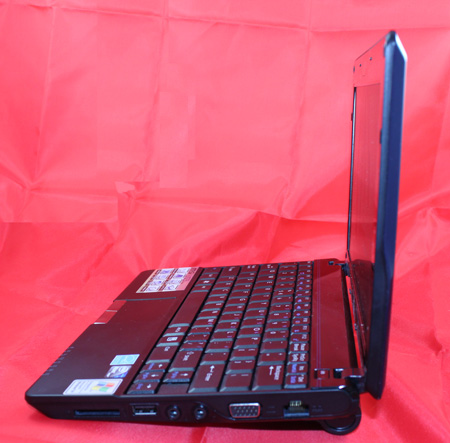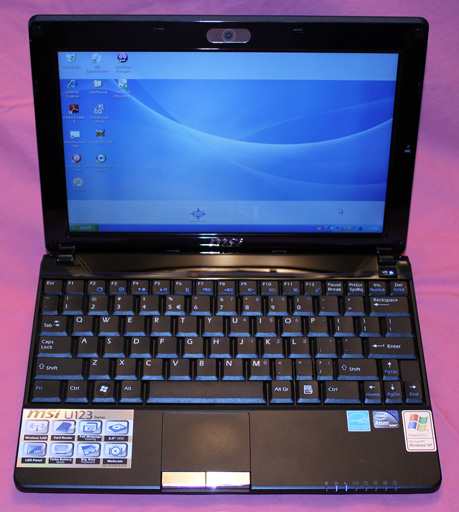MSI Wind U123 and ASUS 1000HE Show Netbook Evolution
by Wesley Fink on July 17, 2009 12:02 AM EST- Posted in
- Laptops
MSI Wind U123 Hands-On
The Wind U123 caused quite a stir at this year's CES, but it took a while to make it to market in this less than vibrant economy. The excitement was mostly the result of the biggest battery pack available on any current netbook. With a 9 cell 87 Wh battery the U123 promised huge battery life, and it definitely delivered in our battery life test.

Beyond that the MSI is certainly a slick looking netbook with a standout blue top - also available in white, red, black or gray. Featured are a bright 10" LCD with effective backlight power management, and a clever removable battery pack design that turns the larger 9-cell battery pack into a tilt leg for the computer. The whole package is slightly smaller in both width and depth than the ASUS 1000H series, which features a similar 10" screen.

The U123 is very similar to the earlier U120. The processor has been updated to the latest Intel Atom N280 (from the N270) and the battery is now a huge 9-cell design. As shown in performance testing the N280 is faster than the Atom N270, but the real-world performance improvement is only 4% to 5% and will hardly be noticed by most users. The battery life improvement, on the other hand, makes the U123 the longest battery life we have yet tested in a netbook. This is amazing considering the U123 9-cell design weighs almost exactly the same as the 6-cell ASUS 1000HA also tested in this review.

The MSI Wind U123 keyboard is the same size and layout as the keyboard used on the ASUS 1000HE. The MSI key labeling is larger and easier to see if that is important to you, but the two keyboards look the same. Looks, as they say, can be deceiving, however. The Wind U123 keyboard will not likely be an issue for hunt-and-peck typists, but the switches are somewhat hard to activate and rather imprecise compared to the ASUS 1000HE keyboard. Two fast typists we asked to type on both systems definitely preferred the ASUS keyboard. Two slower typists saw little difference in the two keyboards.
Everyone, however, uniformly preferred the ASUS touchpad, which provides decent feedback. The MSI touchpad by comparison is smaller with very imprecise left and right click keys that feel mushy and have no distinct click position that we could find. The buttons sometimes engage and sometimes don't engage. The touchpad could definitely use a makeover and MSI would do well to take another look at keyboard touch and feedback as well.
Ports are pretty much what you would expect on a $379 netbook. Fortunately there are three USB ports instead of the two ports found on many netbooks. On the right side MSI provides a card reader that accepts several varieties of the smaller flash cards (SDHC/MMC/MS/XD), one USB port, headphone/microphone jacks, and an Ethernet port. The left side adds two more USB ports and the power adapter jack. Stereo speakers, Windows XP Home, Wi-Fi, a 1.3MP webcam, and a 2.5" 160GB hard drive complete the U123 feature list. The battery pack is removable, with 6-cell and 9-cell battery options so the end user can choose the best pack for their needs.

Unlike the ASUS there is no easy bottom access panel to the hard drive or 1GB memory. It appears you can gain access to the netbook board and peripherals by removing seven small screws on the bottom panel. The MSI Wind U123 feels very dense and somewhat heavy with the 9-cell battery pack options. In fact we assumed the U123 would weigh more than the ASUS 1000HE. It was a pleasant surprise that the Wind U123 actually weighed all but the same as the ASUS. That makes the 9-cell MSI design quite an achievement as it delivers the best battery performance yet tested in a package no heavier than other 6-cell designs.
Retail price for the MSI Wind U123 is $379 with street prices as low as $335 for the 6-cell version. The 9-cell option is usually a little more costly at around $400.










42 Comments
View All Comments
fuberwil - Tuesday, September 15, 2009 - link
I think this is just showing the evolution of the netbooks. A relatively recent device that now has everyone clamoring for one due to the size and portability of it. I think MSI is onto something especially with the option of the 9cell battery which can offer up to 10 hours of work time (from what i've read). Partner that with a low price tag with amazing specs then you have the new best friend of every student and businessman. Yea i think they all have their shortcomings such as the mouse track or the keyboard but like any good electronical device give it some time then it will meet consumers needs on almost every level.Hrel - Thursday, August 6, 2009 - link
A device like that would NEVER be worth more than 200 bucks to me, and I'd feel a little rotten about paying anything more than 100. Not to mention it's not really much more portable than a laptop. Laptops just need better battery life so we don't have to chug around with the ac adapter, If my laptop got 12 hours of battery life I'd take EVERYWHERE!!!afkrotch - Thursday, July 30, 2009 - link
I can't see how anyone can recommend these pieces of crap. I've owned an Asus EeePC Seashell and I would never recommend these to anyone I know. I don't care about battery life, size, or weight. The pieces of crap run so freaking slow. On a straight up HTML page, it flies, but once you get into something that's heavy in java, php, etc is lags. It lags when you scroll, move to a new page, etc.For simple websurfing, it fails. If all you plan on doing is typing up on notepad, ya. Go ahead. Have Office 2k7? Play with lag. It lags when I type.
FYI, I cleaned off the XP Home they had on there and installed a clean copy of XP Pro. I thought it would help with the lagging, but needless to say. It didn't.
MamiyaOtaru - Monday, July 20, 2009 - link
stop making glossy bodied netbooks. They look like trash as soon as someone touches them. Also never make glossy screened netbooks. I want to see what I'm working on, not my reflection. WOn't buy any eee past the original 900 because of this.kawatwo - Sunday, July 19, 2009 - link
Futisu and Sony both have 2 Ghz atoms overseas now in the P and the u820. It shouldn' be long before they make there way here. Also, it costs a little more but people always forget Asus own N10J mmodel with the gforce 9300m which makes it a pretty well rounded machine. A 2 Ghz N10 would be pretty remarkable I would think.I'm waiting for the 2 Ghz U820 though as I travel by motorcycle whenever possible.
AstroGuardian - Sunday, July 19, 2009 - link
Hmmm.. 2Hhz? Like 5% more horsepower? Not feeling like waiting for it lol.I think the netbook future will be pushing the limits to portable CPUs and GPUs. Nowdays netbook CPUs are useless except for bare computer needs. Right?
Wesleyrpg - Saturday, July 18, 2009 - link
hey guys, i know the MSI Wind 123 already has an impressive battery life, but how would it perform with an Intel SSD and would there be any better battery life?richwenzel - Saturday, July 18, 2009 - link
The lenovo s12 and the samsung nc20 both have the new via nano. I believe asus has a netbook and possibly dell as well with the nano.the nano supposedly can do blue ray. It would have been nice to see the differences between the two.
the nc20 is a bit pricier, at $500-$550 or so, but the lenovo can be had for around $400.
there is another company call top crown, www.tct.hk that looks they have some interesting developments with the nano
piasabird - Saturday, July 18, 2009 - link
What is the appeal of a miniature laptop which is slow and underpowered? Better yet, just build a small nettop with a real processor. One thing I tend to wonder is why these Atom motherboards are so inexpensive, yet the via Mini-ITX motherboards are so expensive. Maybe it is just mass production fueled by the want of people for a smaller computer. Myself, I think you could just as easily hook it up to an external HD widescreen monitor. This would give such a device more appeal.You could just make a phone that could plug into a monitor. Why carry around a big nettop? I think it is just as possible.
SilthDraeth - Friday, July 17, 2009 - link
My brother bought an EEE specifically to run some DJing software on it, so he didn't have to lug around his Macbook. Unfortunately it couldn't handle it. He then couldn't sell it on Ebay, only scammers tried to buy it.Not blaming the netbook, and he had the money to throw away, and still makes use of it. But something with a bit more horsepower than a slight processor clock speed increase would be very welcome.
Looks like we may have to wait a bit longer though.